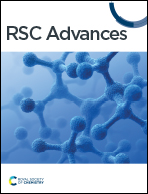3,4-Dimethoxy phenyl thiosemicarbazone as an effective corrosion inhibitor of copper under acidic solution: comprehensive experimental, characterization and theoretical investigations
Abstract
This study investigates the corrosion inhibition potential of 3,4-dimethoxy phenyl thiosemicarbazone (DMPTS) for copper in 1 M hydrochloric acid (HCl) solutions, aiming to disclose the mechanism behind its protective action. Through an integrative methodology encompassing electrochemical analyses—such as weight loss measurements, potentiodynamic polarization, and electrochemical impedance spectroscopy (EIS)—we quantitatively evaluate the corrosion protection efficacy of DMPTS. It was determined that the optimal concentration of DMPTS markedly boosts the corrosion resistance of copper, achieving an impressive inhibition efficiency of up to 89% at 400 ppm. The formation of a protective layer on the copper surface, a critical aspect of DMPTS's inhibitory action, was characterized using Scanning Electron Microscopy (SEM) and Atomic Force Microscopy (AFM). These techniques provided empirical evidence of surface morphology modifications and roughness changes, affirming the formation of a protective barrier against corrosion. A significant advancement in our study was the application of Attenuated Total Reflectance Fourier Transform Infrared (ATR-FTIR) spectroscopy, which identified chemical adsorption as the definitive mechanism of corrosion inhibition by DMPTS. The ATR-FTIR results explicitly demonstrated the specific interactions between DMPTS molecules and the copper surface, indicative of a robust protective adsorbed layer formation. This mechanistic insight, crucial to understanding the inhibitory process, aligns with the protective efficacy observed in electrochemical and surface analyses. Theoretical support, provided by the Quantum Theory of Atoms in Molecules (QTAIM) and quantum chemical computations, further validated the strong molecular interaction between DMPTS and copper, corroborating the experimental findings. Collectively, this research not only confirms the superior corrosion inhibition performance of DMPTS in an acidic setting but also elucidates the chemical adsorption mechanism as the foundation of its action, offering valuable insights for the development of effective corrosion inhibitors in industrial applications.



 Please wait while we load your content...
Please wait while we load your content...